Gwanghallu Pavilion
In Namwon City
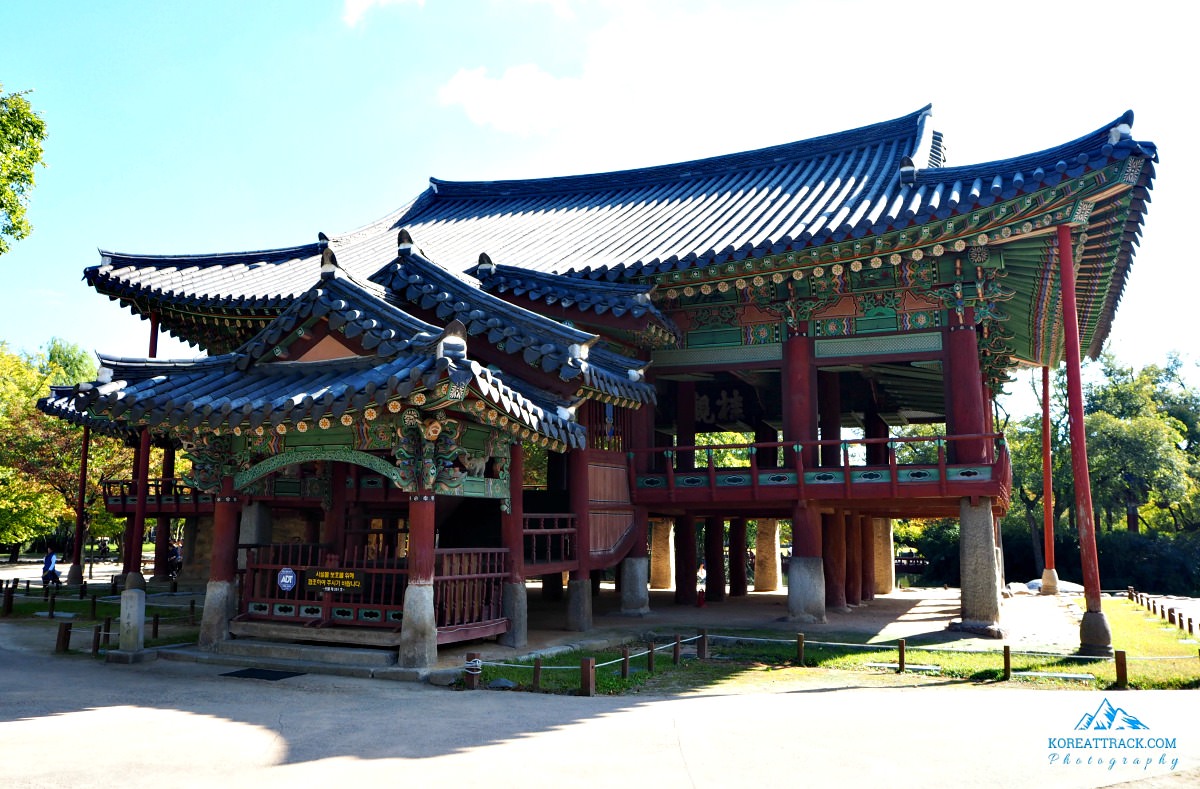 Frontal side view of the Pavilion
Frontal side view of the PavilionIntroduction
Welcome to Namwon City, a charming and historic destination in South Korea that holds a treasure trove of cultural delights.
Nestled within this picturesque city is the enchanting Gwanghallu Pavilion, a timeless masterpiece that beckons visitors to step back in time and immerse themselves in the splendor of Korea's rich heritage.
Perched on the banks of the serene Geumjin River, Gwanghallu Pavilion is a living testament to the country's glorious past. Built during the Joseon Dynasty in the 16th century, this architectural gem served as a gathering place for scholars, poets, and artists, who sought inspiration in its tranquil surroundings.
The pavilion's name, "Gwanghallu," which means "viewing the moon," captures the essence of the ethereal beauty that unfolds here, particularly during moonlit nights.
As you approach Gwanghallu Pavilion, you'll be captivated by its elegant and graceful structure. The pavilion's exquisite design, featuring intricate wooden carvings, delicate roof tiles, and majestic pillars, reflects the impeccable craftsmanship of the era.
Stepping onto its wooden floors, you'll be transported to a bygone era, where the echoes of past conversations and poetic verses seem to linger in the air.
Beyond its architectural splendor, Gwanghallu Pavilion holds a special place in Korean literature and folklore. It is intimately linked to the touching tale of Chunhyang, a timeless love story that has captured the hearts of generations.
This tragic yet inspiring narrative adds a layer of romance and mystique to the pavilion, making it an even more compelling destination for those seeking to delve into Korea's cultural heritage.
Surrounded by a picturesque landscape of lush gardens, Gwanghallu Pavilion offers a serene retreat from the hustle and bustle of modern life. The meticulously manicured lawns, vibrant flora, and tranquil ponds create a peaceful atmosphere, inviting visitors to take a leisurely stroll and bask in the serenity of their surroundings.
During spring, the cherry blossoms paint the scene with delicate shades of pink, while autumn brings a breathtaking display of fiery hues that reflect on the river's calm waters.
Visiting Gwanghallu Pavilion is not just about admiring its beauty; it's also an opportunity to delve into the city's vibrant cultural scene.
The pavilion hosts various events and festivals throughout the year, showcasing traditional music, dance performances, and even reenactments of the beloved Chunhyang story. These celebrations provide a glimpse into the customs and traditions that have shaped Namwon City, allowing visitors to forge a deeper connection with its rich heritage.
Whether you are a history enthusiast, a lover of literature, or simply a wanderer seeking a tranquil escape, Gwanghallu Pavilion promises an unforgettable experience. Step into this hallowed space, where the echoes of the past resonate with the present, and immerse yourself in the beauty, romance, and cultural significance that define this remarkable destination in Namwon City.
Gwanghallu Pavilion & Garden
Gwanghallu Pavilion is a very popular architectural attraction first built in the 15th century in Namwon City.
Gwanghallu has initially been called the Gwangtongnu, which was built by Hwang Hui, a famous early Joseon statesman exiled in this very place.
It was during the 26th year of King Sejong's reign (1444) when this pavilion was renamed with Gwanghallu by Jeong In-Ji. Jeong thought that this pavilion resembles the moon palace Gwanghan Cheongheobu.
 Backview of the pavilion with its reflection on the lake
Backview of the pavilion with its reflection on the lakeMore Historical Background
The original Gwanghallu Pavilion was burnt to ashes in 1597 by Toyotomi Hideyoshi. This happened during the second invasion by the Japanese force against the Korean troops.
The present Gwanghallu structure was built in 1626 during the 4th year of King Injo's reign.
Notice the stairs at the north center of the building. That was an addition by King Gojong to support the structure that started to tilt during his reign in the Joseon period.
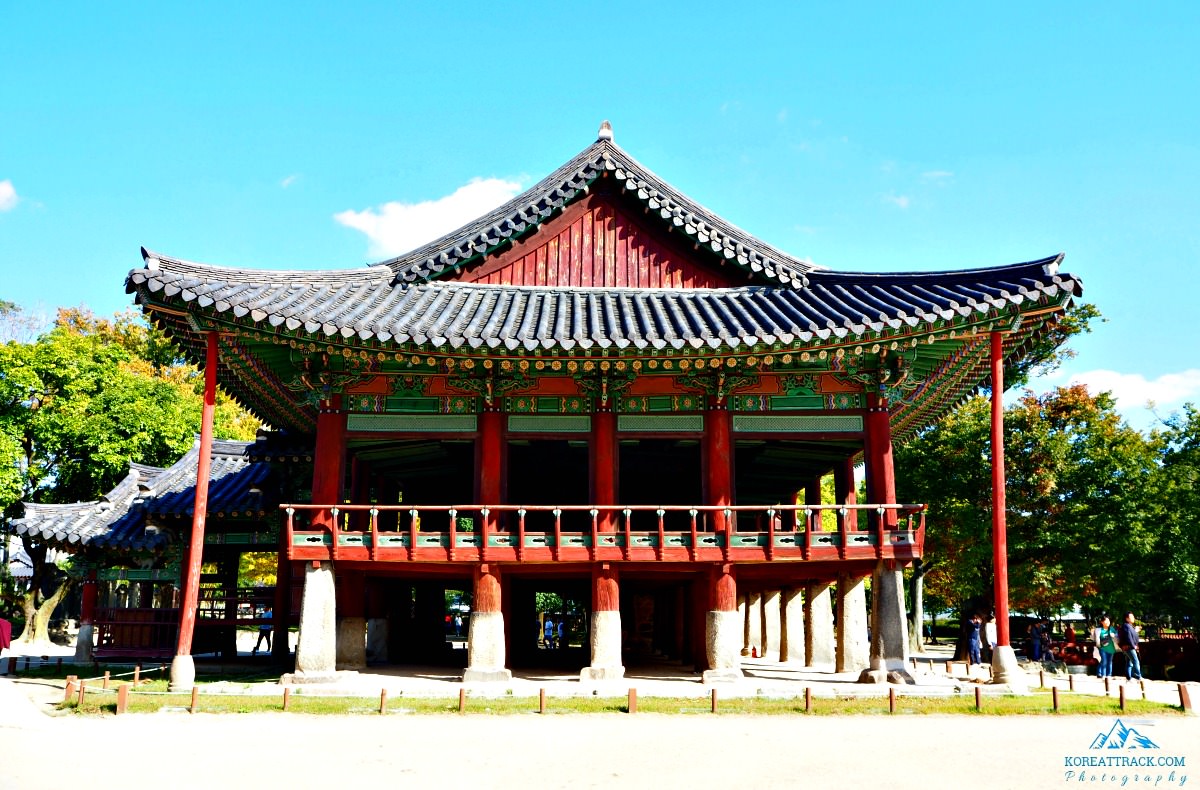 Side view of Gwanghallu Pavilion
Side view of Gwanghallu Pavilion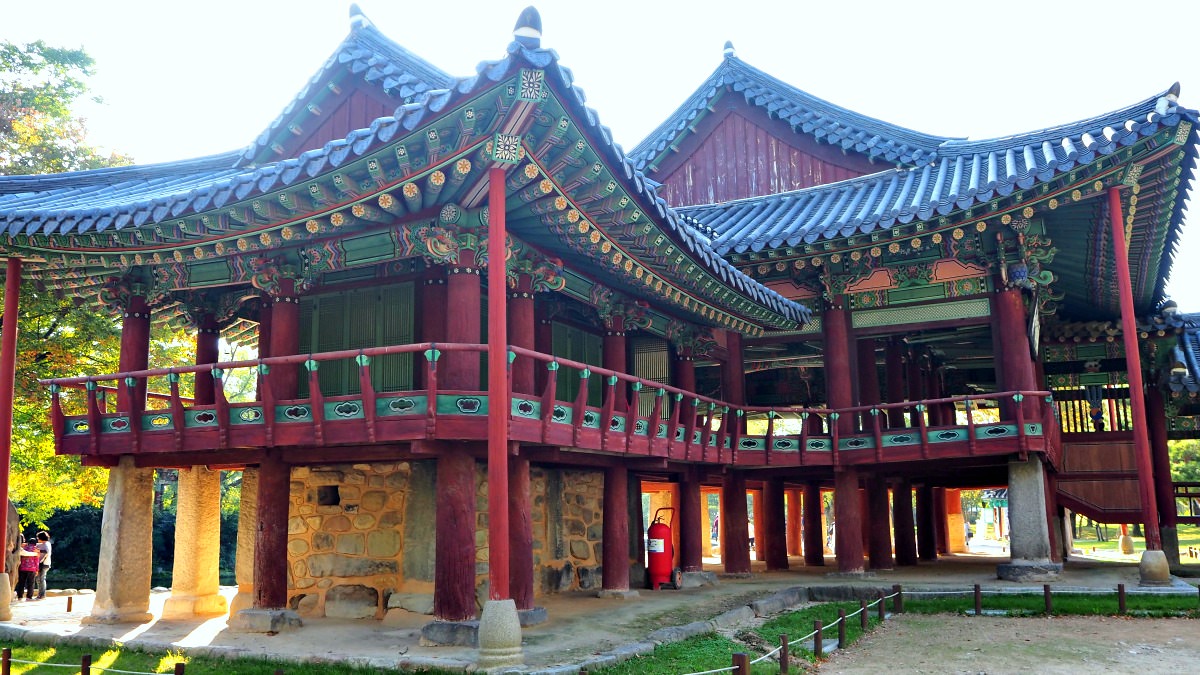 Gwanghallu Pavilion in Namwon City
Gwanghallu Pavilion in Namwon City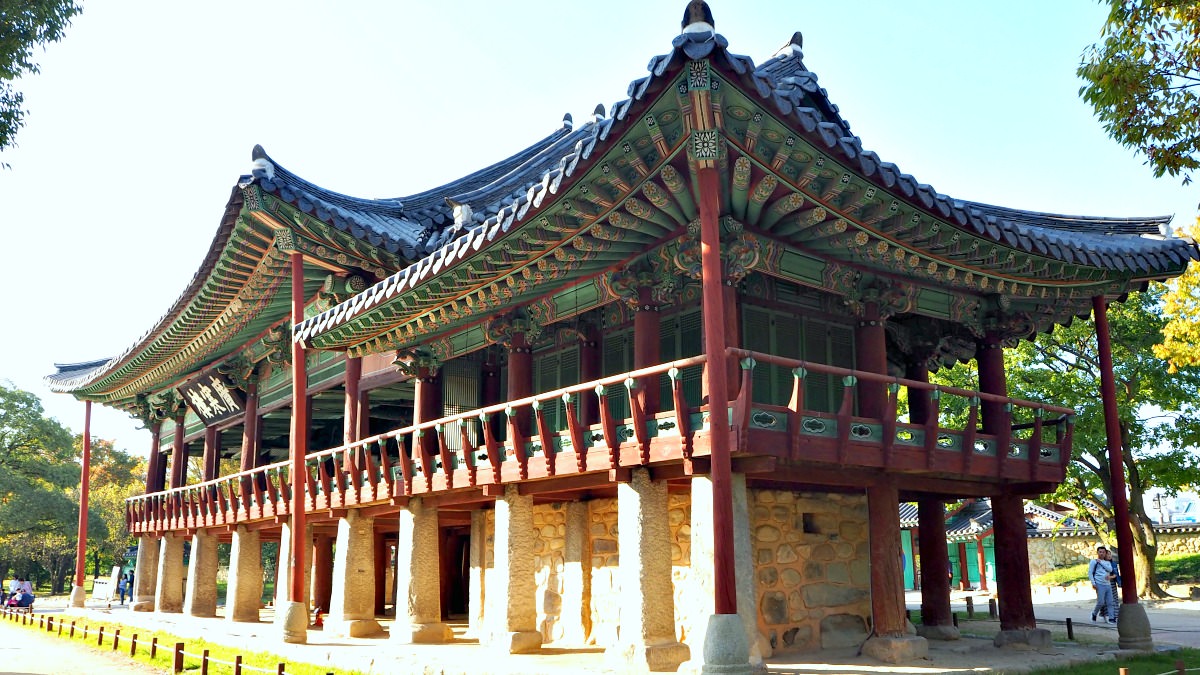 Gwanghallu Pavilion, Namwon City
Gwanghallu Pavilion, Namwon City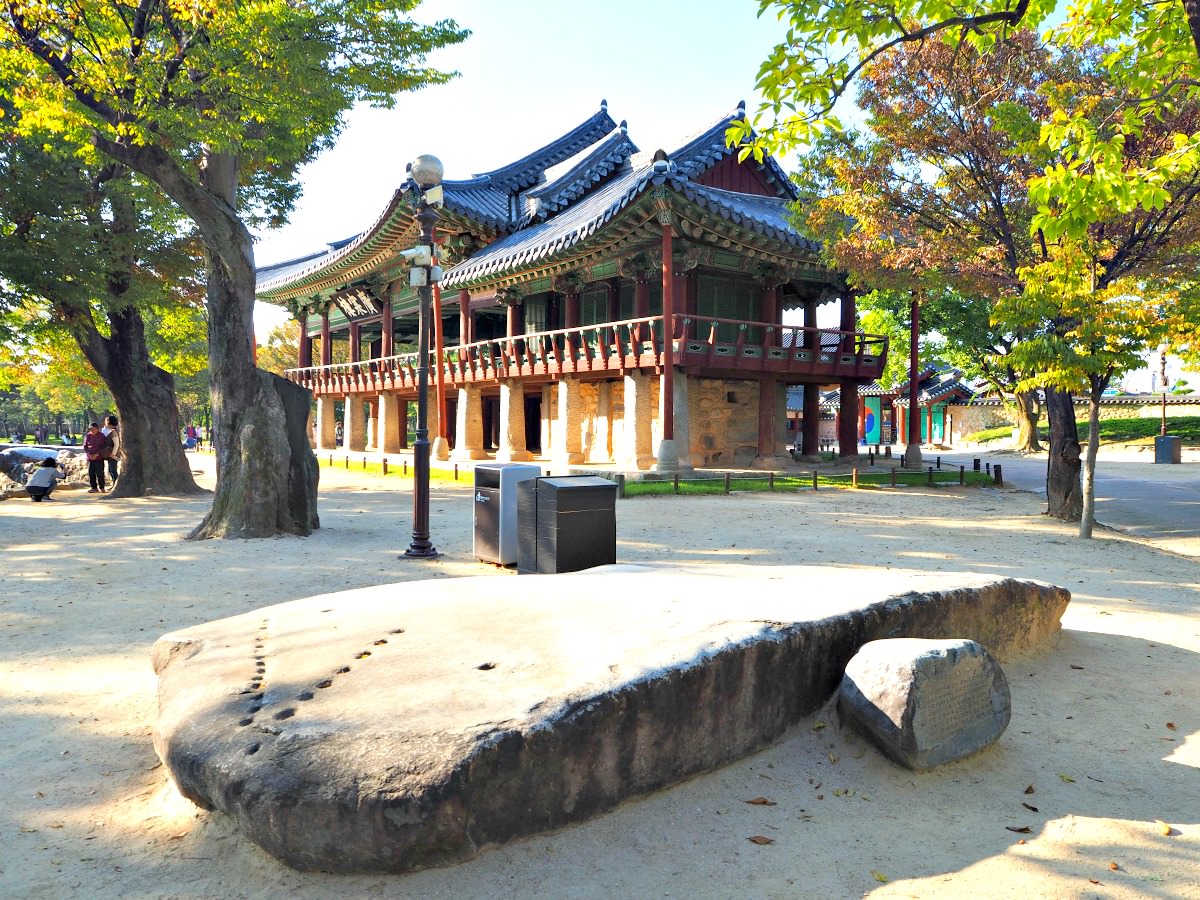 Flat solid stone nearby Gwanghallu Pavilion.
Flat solid stone nearby Gwanghallu Pavilion.The Bridge
Jeong Cheol, a great poet and Confucian statesman, built a stone bridge in 1582 during the reign of King Seonjo.
Jeong built it in front of the Gwanghallu Pavilion and called the bridge Ojakgyo, which means "Crow and Magpie Bridge" with a semi-lunar arch.
Story Behind The Bridge
Legends say that Ojakyo Bridge was created above the Milky Way by crows and magpies. The purpose was to let Gyeonu and Jingnyeo reunite once a year. The two lovers turned into stars.
Gyeonu and Jingnyeo are known as Altair and Vega, respectively, in the West. It is said that if you cross this bridge, your dream love will come true, just like what happened to Chunhyang and Yi Mong-ryong.
The water that flows below the bridge towards Jirisan Valley symbolizes the Milky Way. I think that if seen from above, this is how the water looks like.
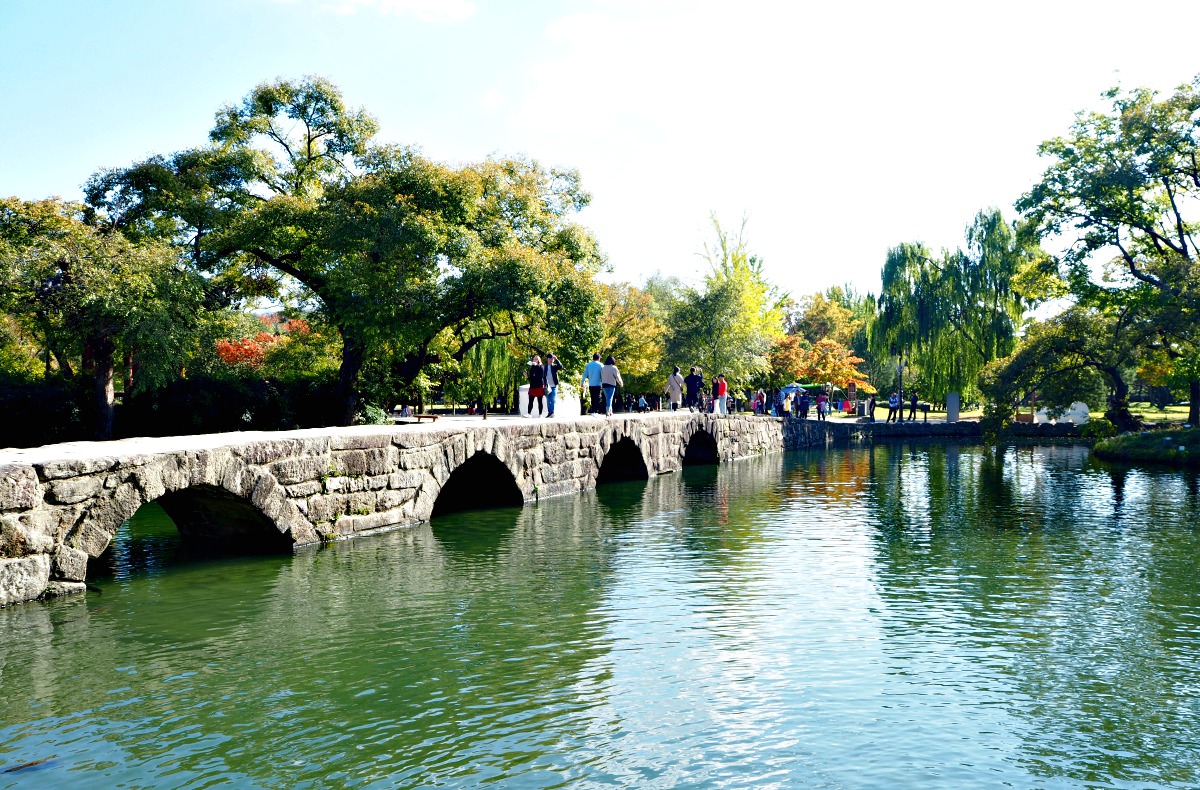 The legendary Ojakyo Bridge
The legendary Ojakyo BridgeThe Pond:
Nestled within the tranquil grounds of Gwanghallu Pavilion, a shimmering pond takes center stage, enchanting visitors with its serene beauty. The pond mirrors the surrounding landscape, reflecting the pavilion's elegant architecture and the lush greenery that embraces it.
Its crystal-clear waters invite contemplation and provide a peaceful respite for those seeking solace in nature. As the gentle ripples dance across the pond's surface, a sense of calm washes over you, transporting you to a world where time stands still.
Koi Fish:
Gliding gracefully beneath the surface of the pond are the vibrant and majestic koi fish. These elegant creatures, with their radiant colors and gentle movements, add a touch of life and energy to the tranquil scene.
The mesmerizing patterns of orange, white, and black that adorn their scales create a vivid contrast against the calm waters. Observing the koi fish gracefully navigate their underwater realm is a meditative experience, as their presence symbolizes good fortune, resilience, and harmony in Korean culture.
The sight of these enchanting creatures evokes a sense of awe and admiration, further enhancing the allure of Gwanghallu Pavilion.
Old Trees:
In the vicinity of Gwanghallu Pavilion, a majestic collection of ancient trees stands tall, silently witnessing the passage of time. These venerable arboreal giants, with their gnarled branches and weathered trunks, exude a sense of wisdom and endurance.
Their sprawling canopies provide shade and sanctuary, offering a cool retreat on warm summer days. Each tree seems to tell a story, bearing the marks of countless seasons and generations that have wandered these grounds.
Their roots, deeply embedded in the soil, serve as a metaphorical connection to the past, anchoring the pavilion's history and culture. As you walk among these ancient sentinels, you can't help but feel a profound sense of reverence and gratitude for the longevity and resilience they embody.
Together, the pond, koi fish, and old trees create a harmonious tapestry of nature's beauty at Gwanghallu Pavilion. They add depth and serenity to the already enchanting atmosphere, inviting visitors to appreciate the delicate balance between man-made structures and the natural world.
The interplay of water, vibrant life, and ancient wisdom embodies the essence of Gwanghallu Pavilion, making it a place of profound tranquility and inspiration.
Getting to Gwanghallu Pavilion
It is pretty easy to get to Namwon City and explore the famous Gwanghallu Pavilion. It takes around four hours by bus or less by speed train from Seoul.
Take a train or bus from Seoul and get off at Nanwon Station or Namwon Express Bus Terminal. Then you can walk to Gwanghallu from the express bus terminal (around 30 minutes), take a taxi or city bus.
More Attractions
Seonwonsa Temple is one of the most important stops in Namwon. Located on a hill overlooking the city, the temple offers stunning views and serves as an important cultural attraction. Visitors can explore its various halls, pavilions, statues and monuments.
The nearby Jungang Underground Shopping Center is another popular destination for visitors to Namwon. This extensive maze of stores is a great place to shop for souvenirs and find unique items. The shops are spread out over four, so it’s easy to become lost in all the activity!
Guryong Waterfalls is a stunning natural attraction located in the nearby mountains. The falls are surrounded by lush, green vegetation and offer visitors a chance to get away from the hustle and bustle of city life. A hike up to the falls is an unforgettable experience and one that should not be missed.
Finally, for those looking for an adrenaline rush, Namwon has several thrilling outdoor activities. Go-karting, ziplining, and bungee jumping are all popular options that offer an exciting experience for visitors of all ages.
No matter what kind of experience you’re looking for, Namwon is sure to have something to suit your needs. With its unique attractions and stunning natural scenery, this city is the perfect destination for anyone seeking a memorable getaway.
- Home
- Jeollabukdo Attractions
- Gwanghallu Pavilion
Get Exciting Activities
Book one of our exciting activities today to experience the thrill of a lifetime! Take advantage of this opportunity and secure your spot in advance.
Hotel Map Guide
Find your affordable, accessible, and comfortable hotel in Seoul at Agoda.Com. See the hotel map below...
Hotel Booking Guide
Find affordable and amazing hotels on Agoda.com using the search box below. Book now to enjoy great discounts and save!




New! Comments
What do you think about this page? Leave me a comment in the box below.